QuestionQUESTION: Hi Diane,
I have a young leopard gecko (about a little over 5in long from nose to tail) that just stopped eating. When I first got her (from Petco, unfortunately)she started munching down in no time. She was never a good hunter but did manage to catch her small sized crickets when given enough time. She was fed crickets about 4-6 daily and then introduced to mealworms. For about a week or so, she did fine in a varied diet or mealworms and crickets, but seemed to start being picky with wanting mealworms more. She would get up to 8 mealworms a day on days she was getting mealworms. Then she just decided she had enough of crickets and stuck to only eating mealworms. Now, she simply will not eat! The tank has a humid hide box (she stays in it a lot), a hide hut on the cooler side, fresh water, calcium dish w/o d3 available, a stick from a lemon tree baked for 3 hrs for her to climb on (she does play on it often. The substrate is paper towels. Her humid hide box substrate is damp beaked moss topped with damp, warm paper towels. She has not used the restroom for 2 days now and has not eaten for almost a week! When she did eat, she had her insects coated with Zoo Med Reptivite w/ d3. She often has her left eye squinted but does open both very wide. I've tried a feeding method in which I take off a cricket's head and push out some of the guts in hopes licking the guts will stimulate her desire to eat. It has not, and she only turned away after licking a few times. Is there anything I can do to help her eat? Or is this quite normal for a young leopard gecko?
ANSWER: Hi Michael,
From reading your questions, I see you are really paying attention to what your leo is doing..that is great!!! To start off...yes, they can go off food for a bit, but with young ones it is generally a care issue in some way. You don't mention bottom heat(under tank heater) Please see info on this in care sheet below.
One problem I see is that she doesn't have a hide on the warm side...only a humid hide. Leos come from a dryer climate and need to have a warm, dray area for most of their day. She is staying in the humid hide because she needs the warmth and the hide...but she does not need the constant humidity. Provide a hide on the warm side and see if that helps her.
I would try giving her a warm, shallow soak... do not leave her alone when doing this!! Do not make the water any deeper than her elbow when she is laying down. This may help her to poop...if she is straining to go to the bathroom, she may have a blockage from eating mealworms only. Mealworms contain a large amount of hard outer body which can cause internal blockages. If you feed mealworms, I suggest raising your own(very easy to do) and that way you can always have a good supply of the freshly shed mealies to feed her. These are the ones that are white(not the transforming to beetles) and soft so don't contain the hard outer body.
Leos won't eat non moving food.... for the crickets, try breaking the hind legs off..this stops them from jumping and can then be fed from a dish. You can also try some other insects.
Also, try offering a chunk of watermelon for her to lick on which will get more water into her in case she is a bit dehydrated.
I'm including a basic care sheet that I wrote to give you more info..please feel free to print it out.
Do not coat her insects with the supplement more than 2 days a week. 2 days a week, coat with a a plain calcium powder..one that has nothing added. Also, place a milk jug lid of calcium in her tank to lick at when she wants it.
BASIC CARE FOR A LEOPARD GECKO
Leopards are pretty easy to care for but they do need
special care. Here are some of the basic needs of your gecko.
HOUSING: The need to have at least a 20 gallon long tank for one Leo. This needs to have a secure fitting screen top...they can be quite the escape artists!!! They need to have a humid hide box.You can make this with something as simple as a small plastic dish with a hole cut in one side and a small mesh bag filled with some Sphagnum moss coconut bark or Peat moss that you mist.
I made mine out of the small plastic Folgers coffee containers...I cut an opening in the lid..and put the moss in..they LOVE it. I use the terrarium moss in mine.
I use that on the warm side of the tank. Be sure to provide a cool hide box on the other end. I also provide a mid temperature hide...which is in the middle of the tank.I use the critter caves which you can purchase. NOT the ones that have heat in them!!!!
Provide secure climbing areas for your gecko. Fake plants, rocks and branches are all fine to use. be sure there are no wires or sharp ends to any fake plants you use.
*****SUBSTRATE:(that's the stuff on the floor of your tank) Newspaper, lizard carpet or paper towels work great and are easy to clean and are much safer than any loose substrate. Sand or other loose substrate is not recommended as that they can be deadly to the leo when it is ingested(eaten, even by accident while eating their insects)...A very graphic site of an impacted leo surg can be seen at http://homepage.mac.com/exoticdvm/reptile/PhotoAlbum181.html it is very graphic!!! ******What I have found that works great for safety and heat distribution is using about 1/4 inch of children's play sand(since the tiles fit tight together, there is no sand danger) on the bottom of the tank and on top that you place ceramic or slate floor tile. What is nice is that the 12 x 12 squares fit perfect in a 20 gallon tank with no spaces between the tiles. The sand and the tile distribute the heat wonderfully. Using the under tank heater as described is what distributes the heat. Also
, overhead heat will help in heating the tiles...I've been using this set up for several years and the leos love it. Using a tile that isn't smooth is recommended. **********
TEMPERATURES: They need a warm area ( on the floor) of 88-92 degrees and a
cooler area in the upper 70s, low 80s. At night their temperature can drop to the low to mid 70's.
Never use a hot rock for a leopard gecko...or any reptile.
They can severely burn any reptile. You can use a heating
pad under the tank,under tank heater for the warm area. You can use a regular household light bulb in a dome fixture with a ceramic socket in it to keep the warm area at the 88-92 degree area if needed there, otherwise, placing the light bulb about midway in the tank will give the needed temperatures throughout the tank. You may have to play with the wattage of the bulb but generally 40-60 watts is sufficient.At night, no white light. If room temperatures stay above 70 degrees, no extra night heat is needed. The under tank heater or heating pad should cover about 1/3 of the tank....be sure to raise the tank up about 1/4-1/2 inch off the stand when using an under tank heat source to prevent heat build up which can cause the glass to break and hot spots in the glass. Be sure to have a good layer of newspaper, carpeting or, even a thin flat rock(such as tile) on top the area that the under tank heat source is placed...if you use a thin rock or tile, it helps to distribute the
heat very well.
You can use the special nighttime lights that are designed for reptiles. I like using a ceramic heat emitter on a thermostat for nighttime heat.
DO NOT use black lights or party lights as they can cause eye damage!!!!
The wattage you use will vary based on room temperature and size of tank.
LIGHTING: Leopard geckos do not need UVB lighting but it does not hurt them to give them uvb. They should have some type of light during the day, be it a uvb tube, regular florescent light, reptile day light or regular household light bulb. NO white lights at night!!!
FEEDING: Geckos should not be fed crickets or other insects that are bigger than the space between their eyes. Generally, hatchlings can be fed more than once a day,juvys can be fed twice a day, adults are fed once daily or every other day, in the early evening. Crickets and other food items such as silk worms, super, and an occasional treat of a wax worm, need to be dusted with a calcium supplement two times a week and also they should have a small dish of calcium in their tank. I use the lid of a milk jug for the little dish of calcium in their tank. For dusting the insects, Use a calcium with no added phosphorus. Insects must be gut loaded(fed) for at least 48 hours prior to feeding your gecko. Remove any uneaten crix or superworms after 15-20 minutes..... Place a piece of cut potato in the tank so that if you have missed any uneaten insects, they will eat the potato instead of nibbling on your gecko!!!
*************You have to be sure to feed your crickets and insects the right foods before feeding them to your gecko. If your crickets/insects are not healthy and well fed, your gecko will not get the nutrition he needs. You can gut load your crickets and insects greens, veggies, cereals or specially designed commercial foods for crickets or the insects you are feeding. ************
Be sure to have a small dish of clean water for your gecko at all times!!
You can offer them some baby food or fruits on occasion ...
Mine will even eat a small piece of watermelon now and then.WATER: always provide a dish of drinking water. If you choose to mist your gecko to drink, its best to not get the tank too wet as that they do not do well with higher humidity. Sometimes its better to take your leo out of their tank to mist them to get them to drink!!!
HANDLING: Some geckos enjoy being held...others prefer not to be handled at all. Be sure to be very gentle when holding your leo and NEVER grab them by the tail! Their tails are extremely fragile and will break.
I do suggest finding a vet that can treat reptiles BEFORE you actually need one!!! To find a vet that is able to care for reptiles:
http://www.herpvetconnection.com
http://www.arav.org/ECOMARAV/timssnet/amm/tnt_mdsearch.cfm
http://www.anapsid.org/vets/
For more information on leopard geckos:
http://www.drgecko.com
If you have any questions or don't understand something, please let me know.
---------- FOLLOW-UP ----------
QUESTION: Thanks for the help! I've always had a hide on the warm side (which is warm because of an undertank heater) and didn't actually add the humid hide until about a few days ago in hopes that she was just simply having trouble shedding. She often stayed in a warm corner instead of resting in the hide anyways, so I moved the original warm hide to the cooler side. A cap of calcium was added and I saw her licking at some last night. I've tried adding crickets, even more than she would normally get, so like 10 at once, a week ago, hoping that the movement would spark her hunting, but it didn't. I tried again the next day to no luck. I've never used a dish or bowl to hold her food and would just let them walk near her and she would pounce. I did this with mealworms before and it worked fine. Now, she shows no interest. She did poop in her poop corner today, but it is very very minimal. I also forgot to mention this, and it may be important. The day before she lost her appetite, she had her tongue in between her lips for about 10 minutes (maybe more because when I went to observe, it was already like that) and then kind of opened her mouth wide, stuck her tongue out as far as it would go and shook her body for a second. I will try the bath and see if it works!
AnswerHi Michael,
OK>.she may have stayed in the humid hide that long so that she can shed... they know what they need in that area. be sure to provide both the humid hide on the warm side and also the regular hide on the warm side, and of course a hide on the cooler end.
Many times they do weird things with their mouth..like they forget their tongue is out..since they pull scents into their mouth with their tongues, we generally assume they are taking in the scents.
Do try feeding from a straight side dish(like an ashtray)..glass works well so that the mealworms cannot climb up the sides. Since she hasn't been eating, the poops will be smaller.
Be sure to keep her hydrated and offer different insects, such as a few wax worms.
If she has a nice fat tail, you can also try not offering her any food for a day or two at the most...she may decide she better eat while it is there. If she continues to not have any interest in eating, you will have to get her to a vet to see if there is some medical reason for her not wanting to eat.

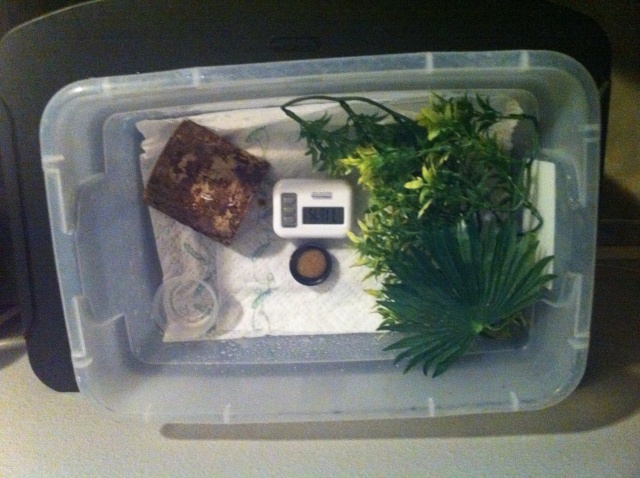 babe crested gecko
Question
crested gecko tub
i just got my crested gecko
babe crested gecko
Question
crested gecko tub
i just got my crested gecko
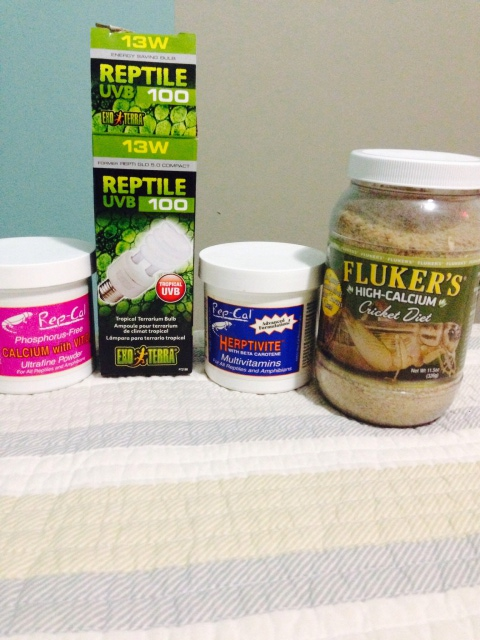 Frilled dragon
QuestionQUESTION: Hello Tracie. I have a frilled dragon
Frilled dragon
QuestionQUESTION: Hello Tracie. I have a frilled dragon
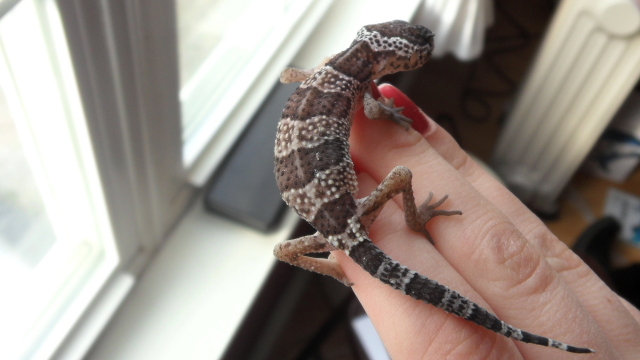 Baby Leopard Gecko with Diarrhea
QuestionQUESTION: Tracie,
Less than 48 hours ago, I bo
Baby Leopard Gecko with Diarrhea
QuestionQUESTION: Tracie,
Less than 48 hours ago, I bo
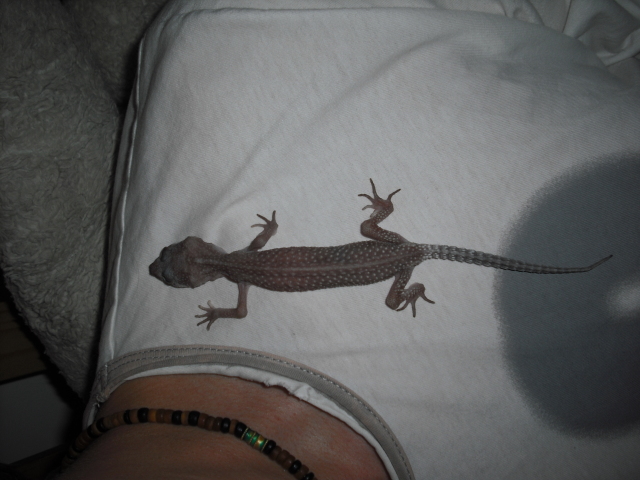 Leopard Not Eating
QuestionQUESTION: We have 3 leopard geckos. We have had
Leopard Not Eating
QuestionQUESTION: We have 3 leopard geckos. We have had
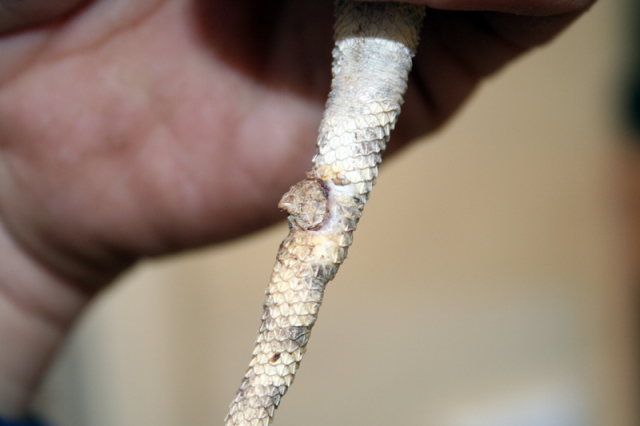 Egyptian Agama
Question
Egytian Agama tail 1
Hello Diane
I recently
Egyptian Agama
Question
Egytian Agama tail 1
Hello Diane
I recently